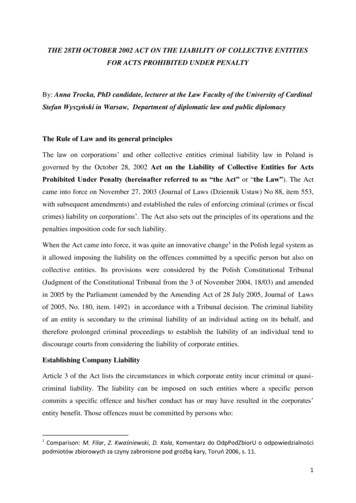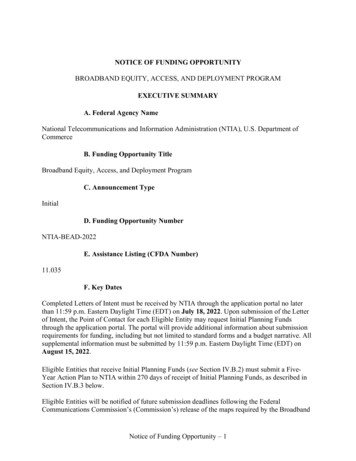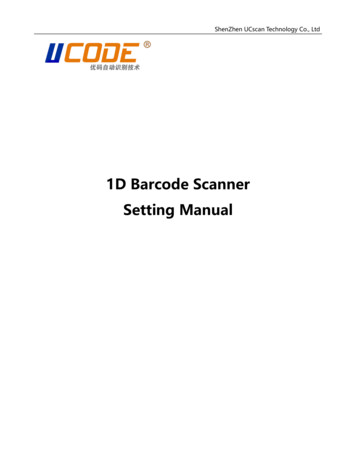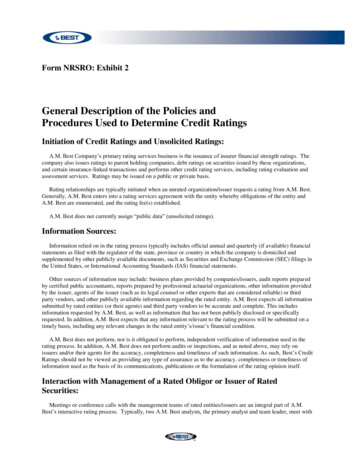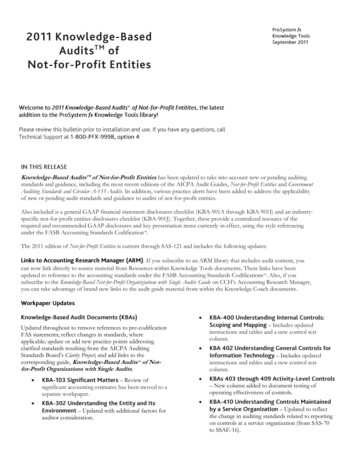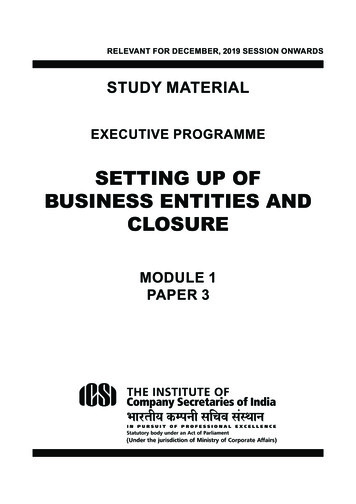
Transcription
RELEVANT FOR DECEMBER, 2019 SESSION ONWARDSSTUDY MATERIALEXECUTIVE PROGRAMMESETTING UP OFBUSINESS ENTITIES ANDCLOSUREMODULE 1PAPER 3i
THE INSTITUTE OF COMPANY SECRETARIES OF INDIATIMING OF HEADQUARTERSMonday to FridayOffice Timings – 9.00 A.M. to 5.30 P.M.Public Dealing TimingsWithout financial transactions – 9.30 A.M. to 5.00 P.M.With financial transactions – 9.30 A.M. to 4.00 si.eduE-mailinfo@icsi.eduLaser Typesetting by AArushi Graphics, Prashant Vihar, New Delhi, andPrinted at M P Printers/June 2019ii
EXECUTIVE PROGRAMMESETTING UP OF BUSINESS ENTITIES AND CLOSUREThere are various business structures such as Companies, LLP, Trusts, and Societies etc. which one canchoose to start a business. Choosing a form of business entity is crucial to a successful organization. Thechoice of a business entity will depend on an object, benefits, size of the business of such entity and manyother factors. The main types of business entities in India are Sole Proprietorship, Partnership, Hindu UndividedFamily (HUF) Business, Limited Liability Partnership (LLP), Co-operative Societies, Branch Office and Companywhich may be any kind of company including one person company (OPC), private limited company, publiclimited company, company limited by guarantee, subsidiary company, statutory company, insurance companyor unlimited company, company formed under section 8 of the Companies Act, 2013 or under section 25 of theearlier Companies Act, 1956.Various laws are applicable for proceeding to incorporate a business entity. Initial Registrations like Shops &Establishment, FSSAI, ISO, MSME, copyright, patent etc. and licences from the regulatory authorities like RBI,IRDA, GST, Income Tax, IPR etc. need to be obtained.In this scenario of various options for the kind of business entity and the plethora of laws applicable to thebusinesses, it becomes quite crucial to know and understand the laws associated with a particular form of thebusiness in order to initiate successful setting up of the business and prolific closure, whenpreferred to servethe best end of all the stakeholders.Therefore, with the objective to provide the working knowledge and understanding of the various proceduralrequirements involved in the setting up of business entities and overview of procedures involved in closureof entities to the students, this study material is published to cover the entire subject into three parts. PartA discusses the Setting up of Business and its various aspects, Part B is devoted to the exhaustive list anddetailed procedures related to Registration, Licenses and Compliances applicable for setting up the businessessuccessfully and Part C deliberates upon Insolvency, Winding up and Closure of Business.With this, the study material to this subject becomes a One Spot Source of knowledge and understanding forefficaciously setting up business in India while subsuming compliance with all requirements of Registration andLicences, along with overview of the procedures related to Insolvency, Winding Up and Closure.After going through this study material and the practical training, the student should be able to - Assist information of various kinds of Companies (Certification part would be at Professional Programme); Setting oftrust, societies, LLP; Setting up of other various entities at small level: Sole Proprietorship, Partnership, HUFetc.; Assist in post formation activities like - PAN; TAN;Open bank account; Assist in post formation registrationincluding MSME registration; GST registration; IPR registration; Registration under shop & establishment law;Compliance under various pollution & environmental laws; Registration under various labour laws; Assist inregular compliances under various labour laws; Assist in closing up of business and alike.With this objective in mind, a number of procedures have also been included at relevant places.Besides, as per the Company Secretaries Regulations, 1982, students are expected to conversant with theamendments to the law made up to six months preceding the date of examination.The legislative changes made upto April 01, 2019 have been incorporated in the study material. However, onhand, where the subject of Setting up of Business Entities and Closure is inherently fundamental to start anykind of business in India, on the similar end it is subject to the refinement of Legislation, Rules and Regulations.iii
Henceforth, it becomes necessary for every student to constantly update with legislative changes made as wellas judicial pronouncements rendered from time to time by referring to the Institute’s monthly journal ‘CharteredSecretary’, E-Bulletin ‘Student Company Secretary’ as well as other legal and professional journals along withthe aid of reference books related to the subject.In the event of any doubt, students may write to the Directorate of Academics of the Institute for clarification.Although due care has been taken in publishing this study material, the possibility of errors, omissions and /ordiscrepancies cannot be rules out. This publication is released with an understanding that the Institute shall notbe responsible for any errors, omissions and /or discrepancies or any action taken in that behalf.Should there be any discrepancies, errors or omissions noted in the study material, the Institute shall be obliged,if the same is brought to its notice for issue of corrigendum in the e-Bulletin ‘Student Company Secretary’.iv
THE LIST OF LAWS COVERED UNDER THE STUDYlAir (Prevention and Control of Pollution) Act, 1981lBanking Regulation Act, 1949lBeedi Workers Welfare Fund Act, 1976lBiodiversity Act, 2002lBuilding & Other Construction Workers (Regulation of Employment & Conditions of Service) Act, 1996lChild and Adolescent Labour (Prohibition and Regulation) Act, 1986lChit Funds Act, 1982lCompanies Act, 2013lContract Labour (Regulation and Abolition) Act, 1970lCopyright Act, 1957lCine Workers Welfare Fund Act, 1981lDesign Act, 2000lDrugs and Cosmetics Act, 1940lEmployees’ Provident Funds and Miscellaneous Provisions Act, 1952lEmployee’s State Insurance Act, 1948lEnvironment (Protection) Act, 1986lFactories Act, 1948lFEMA, 1999lForeign Contribution Regulation Act, 2010lGeographical Indication of Goods (Regulations and Protection) Act, 1999lGoods and Services Act, 2017lHazardous Wastes (Management, Handling and Transboundary Movement) Rules, 2008lIncome Tax Act, 1961lIndustrial (Development and Regulations) Act 1951lIndustrial Disputes Act, 1947lIndustrial Employment (Standing Orders) Act, 1946lInformation Technology Act, 2000lInterest on Delayed Payments to Small Scale and Ancillary Industrial Undertakings Act, 1993lIron Ore Mines, Manganese Ore Mines & Chrome Ore Mines Labour Welfare Fund Act, 1976lInsolvency & Bankruptcy Code, 2016lInsurance Act, 1938lInsurance Regulatory and Development Authority Act, 1999lInter-State Migrant Workmen (Regulation of Employment and Conditions of Service) Act, 1979v
lLimited Liability Partnership Act, 2008lLimestone and Dolomite Mines Labour Welfare Fund Act, 1972lMaternity Benefit (Amendment) Act, 2017lMica Mines Labour Welfare Fund Act, 1946lMicro, Small and Medium Enterprises Development Act, 2006lMines Act, 1952lMinimum Wages Act, 1948lMotor Transport Workers Act, 1961lNational Green Tribunal Act, 2010lPartnership Act, 1932lPatent Act, 1970lPayment of Bonus Act, 1965lPayment of Gratuity Act, 1972lPayment of Wages Act, 1936lPlantation Labour Act, 1951lPress Council Act, 1978lPress & Registration of Books Act 1867lPrevention of Sexual Harassment of Women at Workplace (Prevention;Prohibition and Redressal) Act,2013lPublic Liability Insurance Act, 1991lRBI Act, 1934lRights of Persons with Disabilities Act, 2016lSecuritization and Reconstruction of Financial Assets and Enforcement of Security Interest (SRFAESI)Act, 2002lShop and Establishment Act, 1948lSocieties Registration Act, 1860lTelecom Regulatory Authority of India Act, 1997lTrade Marks Act, 1999lTrade Unions Act, 1926lThe Industrial Disputes Act, 1947lWater (Prevention and Control of Pollution) Act, 1974lWater (Prevention and Control of Pollution) Cess Act, 1977vi
EXECUTIVE PROGRAMMEModule 1Paper 3Setting up of Business Entities and Closure(Max Marks 100)SYLLABUSOBJECTIVESTo provide working knowledge and understanding of setting up of Business entities and their closure.Detailed Contents:Part A : Setting up of Business (40 Marks)1. Choice of Business OrganizationlKey features of various structures and issues in choosing between business structures includingidentification of location; tax implications etc.2. CompanylPrivate Company;lPublic Company;lOne Person Company;lNidhi Company;lProducer Company;lForeign Company- Liaison Offices; Branch Office & Project Office;lFormation and Registration3. Part I: Charter documents of CompanieslMemorandum of Association and Articles of Association;lDoctrine of ultra-vires;lDoctrine of indoor management; Doctrine of constructive notice;lIncorporation Contracts;Part II: Alteration of Charter DocumentslAlteration in MOA & AOA- Change of name;registered office address; objects clause; alteration in sharecapital and alteration in articles of association.vii
4. Legal status of Registered CompanieslSmall Company;lHolding Company;lSubsidiary Company & Associate Company;lInactive Company;lDormant Company;lGovernment Company.5. Limited Liability PartnershiplConcept of LLP;lFormation and Registration;lLLP Agreement;lAlteration in LLP Agreement;lAnnual and Event Based Compliances.6. Other forms of business organizationslPartnership;lHindu Undivided Family;lSole Proprietorship;lMulti State Co-operative Society;lFormation; Partnership Agreement and its registration.7. Institutions Not For Profit & NGOslSection 8 Company; Trust and Society- Formation and Registration.8. Financial Services OrganizationlNBFCs;lHousing Finance Company;lAsset Reconstruction Company;lMicro Finance Institutions (MFIs);lNidhi Companies;lPayment Banks;lRegistration.9. Start-upslStart-up India Policy;lRegistration Process;lBenefits under the Companies Act and other Government Policies;viii
lDifferent types of capital- Seed Capital; Venture Capital; Private Equity; Angel Investor; Mudra Bank.10. Joint Ventures; Special Purpose VehicleslPurpose and Process.11. Setting up of Business outside IndialIssues in choosing location; Structure and the processes involved.12. Conversion of existing business entitylConversion of private company into public company and vice versa;lConversion of Section 8 company into other kind of Company;lConversion of Company into LLP and vice versa;lConversion of OPC to other type of company and vice versa;lCompany uthorized to be registered under the Act (Part XXI Companies); and other types of conversion.Part B : Registration; Licenses & Compliances (35 Marks)13. Various Initial Registrations and LicenseslllMandatory Registration - PAN; TAN; GST Registration; Shops & Establishments; SSI/MSME;Additional Registration/License - ESI/PF; FCRA; Pollution; Other registration as per requirement ofsector; IE Code; Drug License; FSSAI; Trademark; Copyright; Patent; Design; RBI; Banking; IRDA;Telecom; I & B; MSME Registration; Udyog Aadhar Memorandum; Industrial License, IndustrialEntrepreneurs Memorandum (IEM);State Level Approval from the respective State Industrial Department.14. Maintenance of Registers and RecordslRegister and Records required to be maintained by an enterprise.15. Identifying laws applicable to various Industries and their initial complianceslCompliance of industry specific laws applicable to an entity at the time of setting up of the enterprise.16. Intellectual Property laws (Provisions applicable for setting up of business)lCopyright Act, 1957;lPatents Act, 1970;lTrade Mark Act, 1999;lGeographical Indication of Goods (Registration and Protection) Act, 1999;lDesigns Act, 2000.17. Compliances under Labour Laws (Provisions applicable for setting up of business)lFactories Act, 1948;lMinimum Wages Act, 1948;ix
lPayment of Wages Act,1936;lEqual Remuneration Act, 1976;lEmployees’ State Insurance Act,1948;lEmployees’ Provident Funds and Miscellaneous Provisions Act, 1952;lPayment of Bonus Act, 1965;lPayment of Gratuity Act, 1972;lEmployees Compensation Act, 1923;lContract Labour (Regulation and Abolition) Act, 1970;lIndustrial Disputes Act, 1947;lTrade Unions Act, 1926;lMaternity Relief Act, 196;lChild and Adolescent Labour (Prohibition and Regulation) Act, 1986;ll[Persons with Disabilities (Equal Opportunities; Protection of Rights and Full Participation) Act,1995]*replaced with Right of Persons with Disabilities Act, 2016Prevention of Sexual Harassment of Women at Workplace (Prevention; Prohibition and Redressal) Act,2013.18. Compliances relating to Environmental laws (Provisions applicable for setting up of business)lWater (Prevention and Control of Pollution) Act, 1974;lAir (Prevention and Control of Pollution) Act, 1981;lEnvironment Protection Act, 1986;lPublic Liability Insurance Act, 1991;lNational Green Tribunal Act, 2010.Part C : Insolvency; Winding up & Closure of Business (25 Marks)19. Dormant CompanylObtaining dormant status and dormant to active status.20. Strike off and restoration of name of the company and LLP21. Insolvency Resolution process, Liquidation and Winding-upx
LESSON WISE SUMMARYSETTING UP OF BUSINESS ENTITIES AND CLOSURELesson 1 - Choice of Business OrganizationThe choice of a business organization is driven by a combination of several factors such as nature of activity,capital requirement, degree of independence required, etc. There is no readymade formula for selecting theparticular type of business organization. Tax consideration is also an extremely important factor.Company Secretaries while playing advisory role would help the clients in deciding about the type of organizationone may opt for when considering to start a business.This chapter will cover the factors which are taken into account in choosing a form of business organization.Brief outline of the various forms of business organization is also covered.Lesson 2: Company: Types of CompaniesCompanies may be classified on the basis of their incorporation, number of members, size, basis of controland motive. On the basis of incorporation of the companies, it may be classified into Charter Companies,Statutory Companies and Registered Companies. On the basis of liability, it may be Companies limited byshares/guarantee and unlimited liability companies. Further, on the basis of number of members, they may beclassified into One Person Company, private company and public company. On the basis of size, they may bedivided into small companies and other companies. On the basis of control, they may be classified into holdingcompany, subsidiary company and associate company.Besides, companies may be nonprofit companies licensed under Section 8, Government companies, foreigncompanies, holding/subsidiary companies, investment companies, producer companies etc.This chapter covers the concepts of various types of companies, their legal basis, special provisions andprivileges for some classes of companies, distinction between different types of companies etc.Lesson 3: Part I: Charter Documents of CompaniesThe memorandum and articles of association of a company are the most important documents for the formationof a company and for its functioning thereafter.The memorandum of association contains the name, situation of registered office, objects, capital and liabilityand subscription clauses. The articles are its bye-laws or rules and regulations that govern the managementand internal affairs and the conduct of its business. Both the documents are required to be registered with theRegistrar of Companies at the stage of incorporation of the company.Before dealing with a company, it is advisable to read the memorandum and articles of the company to understandaspects, such as powers of Board, scope of company’s activities etc. and its relationship with the outside world.Since Memorandum sets out the constitution of a company and is therefore the foundation on which thestructure of the company is built. It defines the scope of the company’s activities and its relations with theoutside world. Company Secretary in employment should work within the four walls of the MOA and also subjectto the provisions of AOA.This chapter includes the concept of Memorandum of Association and Articles of Association, their purpose,contents and registration. It also covers doctrine of indoor management and Alter Ego.xi
Lesson 3: Part II: Alteration of Charter DocumentsAlterations that can be carried out in the Memorandum and Articles of Association and effect of such alterations.It also explains the legal effect of these documents.Company Secretary who is holding key position in the company must be aware of the procedural aspects ofalteration of various clauses contained in the Memorandum of Association and of various regulations of Articlesof Association of the Company which may be permissible under the provisions contained in Section 13 andSection 14 of the Companies Act, 2013 to be read with relevant Rules framed thereunder.Lesson 4: Legal Status of Registered CompaniesThis Chapter highlights explains the characteristics of private limited company, public limited company and aOne Person Company (OPC).It also provides an overview of certain other types of companies, such as Small Company, Holding Company,Subsidiary Company and Associate Company, Dormant/Inactive Company. It further explains what is aGovernment Company and the exemptions available to them.Company Secretary should be aware of the distinctive features of different entities.Lesson 5: Limited Liability PartnershipLimited Liability Partnership is governed by the Limited Liability Partnership Act, 2008 and the Rules framedthereunder.In this Chapter, we shall learn about the Limited Liability Partnership (LLP), its formation and registration; It alsocovers the features of an LLP agreement and the manner of alterations therein.LLP is required to make various compliances and file various forms with the Registrar. We shall also study thevarious annual and event based compliances applicable to the LLP.Being compliance professional, Company Secretary should be aware of all the compliance requirements ofvarious business entities including Limited Liability Partnership.Lesson 6: Forms of Business OrganisationsThis chapter include the various forms of business organisation, such as sole proprietorship, partnership, HinduUndivided Family and Multi State Co-operative Societies.The lesson also highlights their respective merits and demerits and the manner in which they can be registeredin India.Lesson 7: Institutions Not For Profit and NGOsIn this Chapter, formation and registration of NGOs, namely, Section 8 Company, Trust and Society is included.Section 8 Company, its features, exemptions available to them and registration process.Trust, difference between public trust and private trust, exemptions available to them, more specifically, underthe Income Tax Act and formation process.Society, its advantages and disadvantages, consequences of non-registration, benefits of forming a Societyand formation process.Company Secretary should have clarity with regard to institutions which are not for profit, their features andformation process.xii
Lesson 8: Financial Services OrganisationsDifferent forms of Financial Services Organisations operating in India such as Non Banking Finance Companies(NBFC’S) and the various categories of such companies, Housing Finance Companies (HFC’s), AssetReconstruction Companies (ARC’s), Micro Finance Institutions (MFI’s), Nidhi Companies and Payment Banks.This Chapter also explains the process of registering such entities.Lesson 9: Start-ups and their RegistrationStartups have emerged as a fast-growing business model. This chapter will deal with the evolution of Startups inIndia, the Startup India Policy, developments initiated in various States to encourage Startups, the exemptionsavailable to them and the registration process.The Chapter also deals with the different kinds of Debt financing and Equity Financing which can be raised byStartups and the concept of MUDRA Banks.It also includes the benefits/ exemptions given to start ups, different financing options available and theprocedures involved for incorporation and registration as startups.Lesson 10: Joint Ventures and Special Purpose VehiclesA Joint Venture (JV) is generally short lived for conducting specific business activities. It is a business agreementin which the parties agree to develop, for a finite time, a new entity and new assets by contributing equity. ASpecial Purpose Vehicle (SPV) is formed for a specific purpose.In this chapter, Joint Venture and Special Purpose Vehicle, their advantages and disadvantages, theircharacteristics and the process for registering these entities are covered.Lesson 11: Setting up of Business outside IndiaIn this lesson, you will learn about the various forms of business organization, such as sole proprietorship,partnership, Hindu Undivided Family and Multi State Co-operative Societies.The lesson also highlights their respective merits and demerits and the manner in which they can be registeredin India.Company Secretaries, while playing advisory role, can guide and help in setting up of business outside India.Lesson 12: Conversion of Existing Business EntityCompanies Act, 2013 provides for conversion of public companies to private companies vice versa, conversionof One Person Company into public/private company, conversion of Section 8 companies (companies forcharitable purpose) into any other class of companies. Companies (Incorporation) Rules, 2014 provides detailsof the procedural aspects.In addition you will be able to understand the overall legal and procedural aspects relating to various conversions.Conversion of existing business entity to other form is a strategic decision which needs to be taken to get thebenefits of one form of business entity over other form for a particular business at a particular point of time.Company Secretaries can help in taking such strategic decisions and implementation of the same.Lesson 13: Various Initial Registration and LicensesA business entity is required to secure various registration and licenses for setting up their businesses inIndia. In India, there are plethora of laws which requires various registrations and licenses to be obtained forsetting up the business unit in India along with ensuring state level compliances. In order to facilitate one spotxiii
understanding, this chapter deals with the list of Mandatory as well as Additional Registration and Licensesalong with their detailed process.Lesson 14: Maintenance of Registers and Records: Register and Records required to bemaintained by an enterpriseThe Companies Act, 2013 (the Act) and the rules made there under (“the Rules”) lays down that every Companyincorporated under the Act has to maintain Statutory Registers (“the Registers”). With various provisionsincorporated in Company Act, 2013, it is made clear that every company governed under Company Act, 2013 isrequired to maintain a statutory register at its registered office until the dissolution of the company. Henceforth,this chapter specifies the list of various registers and records required to be maintained by enterprise.Lesson 15: Identifying laws applicable to various Industries and their initial compliancesKeeping in pace with the contemporary global market and emerging stand of Indian economy, governmentinitiated various flagship programs to boost the entrepreneurship environment in the country. Few of themajor flagships including Make in India” coupled with “Ease of Doing Business in India”, “Skill India”,“Digital India”, etc., are starred to build the interest and ease among various domestic and overseas stakeholders to set up and advance the entrepreneurship in India. Indeed, when the entrance and advancementto Indian business market would be of ultimate fortune, there are various laws which need to be abidedfor successfully setting up and taking forward an enterprise in India. In this perspective, this chapter aimsat proving a quick understanding laws applicable to various industries, their setting up along with thethorough details of their initial compliances.Lesson 16: Intellectual Property laws (Provisions applicable for Setting up of Business)In today’s world, the abundant supply of goods and services on the markets has made life very challengingfor any business, big or small. In its on-going quest to remain ahead of competitors in this environment, everybusiness strives to create new and improved products (goods and services) that will deliver greater value tousers and customers than the products offered by competitors. To differentiate their products - a prerequisitefor success in today’s markets - businesses rely on innovations that reduce production costs and/or improveproduct quality. In a crowded marketplace, businesses have to make an on-going effort to communicate thespecific value offered by their product through effective marketing that relies on well thought-out brandingstrategies. In the current knowledge-driven, private sector oriented economic development paradigm, thedifferent types of intangible assets of a business are often more important and valuable than its tangible assets.A key subset of intangible assets is protected by what are labelled collectively as intellectual property rights(IPRs). These include trade secrets protection, copyright, design and trademark rights, and patents, as well asother types of rights. IPRs create tradable assets out of products of human intellect, and provide a large array ofIPR tools on which businesses can rely to help drive their success through innovative business models. Underthis background, this chapter aims to address various provisions of Intellectual Property Rights applicable forsetting up business in India.Lesson 17: Compliances under Labour Laws (Provisions applicable for Setting up of Business)Labour laws are one important set of welfare legislation for the employees and labour in India. They ensurethat industrial relations are maintained at balance and employees are protected at their social, economic andpolitical welfare. This has made various labour laws being enacted in India to be complied by business entitiesin India. This chapter deals in briefing the provisions of various labour laws applicable for setting up of businessin India.xiv
Lesson 18: Compliances relating to Environmental laws (Provisions applicable for SettingUp of business)With the recognition of Right to Heathy Environment as a human right under the Universal Declaration ofHuman Rights and its related covenants, measures are taken at full force to enforce these rights and guard theright to environment at parity. With the endowed protection to environment under the Constitution and SpecificStatutes, all the personas be it natural or legal including a Company owes a duty to conduct themselves in sucha manner that their act or omission should not pollute the environment. Therefore, a company is necessitated toabide by various laws in order to protect the environment. A brief list of the statutory protection to environmentis discussed in this chapter.Lesson 19: Dormant CompanyCompanies are generally classified on the basis of their incorporation, number of members, size, basis of controland motive. Additionally, companies can also be classified based on their status. Sometimes, the promoters ofa company may feel the need to temporarily close down the company due to various reasons, but they do notwant to dissolve it. In such cases, the company may become dormant as against an active company which iscarrying on business. Thus, on the basis of its status, companies may be classified into active, dormant, underliquidation, under process of striking off, strike off, dissolved, amalgamated, etc. The ‘status’ of the companysignifies the current state of the company - Whether it is active and operating OR dormant OR it has been struckoff and closed.As a company secretary, one must be aware of the procedure of obtaining status of dormant company, activecompany, the compliances involved for a dormant company etc.Lesson 20: Strike Off and Restoration of Name of the Company and LLPOn incorporation, the name of the company and LLP is entered in the Register maintained by the Registrar. Onstriking off, the name of the company/LLP is temporarily removed from the Register. The name of the companycan be restored in the Register on making an application.Lesson 21: Insolvency Resolution Process, Liquidation and Winding Up: An OverviewThe Insolvency & Bankruptcy Code, 2016 consolidate and amend the laws relating to insolvency of companies,partnership firms, limited liability partnership into a single legislation. It aims to provide time bound resolutionand empowered the creditors to initiate the insolvency resolution process if default occurs. The Insolvency andBankruptcy Board of India has notified the Insolvency and Bankruptcy Board of India, Regulations, 2017 onMarch 31, 2017. The New Regulations provides the process for initiating voluntary liquidation by a corporateperson i.e. companies, limited liability partnerships and any other persons incorporated with limited liability formaximization of value of assets of such persons, to promote entrepreneurship, availability of credit and balancethe interests of all the stakeholders including alteration in the order of priority of payment of Government dues.The provisions of this Code shall apply to –(a)any company incorporated under the Companies Act, 2013 or under any previous company law;(b)any other company governed by any special Act for the time being in force, except in so far as the saidprovisions are inconsistent with the provis
BUSINESS ENTITIES AND CLOSURE MODULE 1 PAPER 3 RELEVANT FOR DECEMBER, 2019 SESSION ONWARDS . Phones 011-45341000 Fax 011-24626727 Website www.icsi.edu E-mail info@icsi.edu . Part I: Charter documents of Companies l Memorandum of Association and Articles of Association; l Doctrine of ultra-vires;

